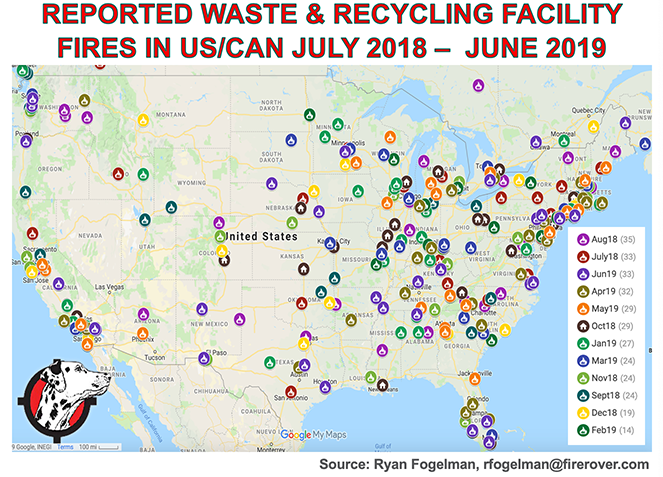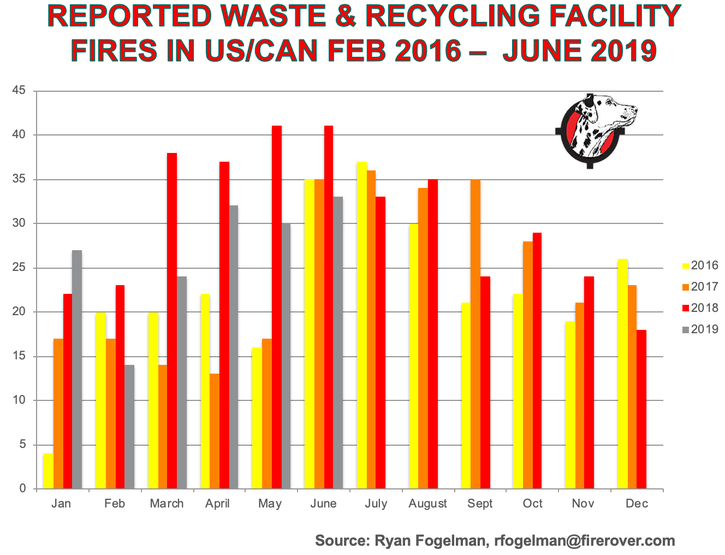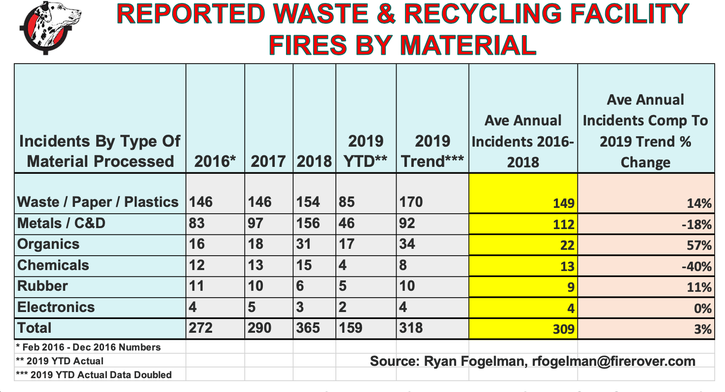June 2019 Updated Fire Report: 10 Firefighters Injured This Month Alone
June brings a disturbing statistic of 10 reported injuries to fire professionals in waste and recycling facilities.
During the past 12 months, the waste and recycling industry has experienced 323 reported facility fires in both the U.S. and Canada. Based on reasonable assumptions, we can extrapolate that 1,800-plus facility fires have occurred during that time, which, based on the number of facilities reported by the Environmental Research & Education Foundation, is more than 40 percent of the industry.

I define “reported” as any fire that has been reported by the media. Typically, those fires are the two-alarm-plus fires that require fire professionals to arrive on scene, which brings us a very disturbing statistic. In June, there were 10 reported injuries to fire professionals in waste and recycling facility fire incidents.
When I first started working with Fire Rover, I was amazed to find out that fire was down the list as a priority in the waste and recycling industry. This wasn’t due to a lack of caring, but as I met with industry consultants, executives, safety and operations folks, I began to understand that unlike truck accidents, landfill slides and compactor issues, fire wasn’t associated with the risk of losing a life. It is true that there have been very few deaths that have occurred in waste and recycling facilities due to fire. Fortunately, when there is a fire incident, employees are typically able to evacuate.
Unfortunately, however, the injuries I see reported in the press around these fire incidents more often than not involve the firefighters fighting these fires. In June, a harsh reality hit. The “summertime” spike in fires that we have traditionally seen held true. April, May and June were the highest months of fires encountered for the entire year.

Those 10 injuries were not due to direct heat, but the indirect heat caused by fighting a fire in the hot weather. The injuries occurred in four separate incidents, including a rubber fire, a plastic fire and two waste facilities fires.
Here are some of the insights behind one of the incidents from Florida-based St. Lucie County Fire District (SLCFD) Battalion Chief Mark Cristaldi:
“This was a high-risk operation ... Two firefighters were sent to a nearby hospital for heat-related injuries. “It is physically and mentally taxing especially in the summertime. When the heat index is extremely high, like it was [June 20], they send extra crews to help so they can stay hydrated and continually check their vitals. Whether we are inside or outside, it’s the same conditions, it’s still hot. We don’t have the ability to dissipate that heat we are putting off. With the required bunker gear, they are adding an extra 40 to 50 pounds to their load. [The fire department says the equipment doesn’t breathe well, so they heat up extremely fast.] Even with a basic car fire, putting your gear on—it feels like an oven."
The major point is that fighting fires in the summertime heat is hard, but imagine fighting a major fire inside a warehouse building filled with smoke and mounds of material feeding the heat source.
The reality of this issue hit me hard while attending my first Federal Deposit Insurance Corporation (FDIC) conference a few years back. I was attending the annual conference, and after sharing with Chief Matthew Colgan how our Fire Rover solution was developed and working to detect and fight fires during their earliest stages at waste and recycling facilities, the chief invited me to his unit’s annual dinner.

During the dinner, the chief got up and started to make a speech, which I thought was going to be for his team, but, to my surprise, he spoke of the issues firefighters have with fighting fires in waste and recycling facilities. His message was focused around the dangers of using a saw to cut an entrance into a metal-sided building and fighting a fire in an operation whose landscape of material piles changes on a daily basis. As one can imagine, firefighters don’t want to fight these types of fires.
Finally, Chief Colgan issued me the challenge coin (shown in the picture above). For those unfamiliar with a challenge coin, they are traditionally given by the commander for recognition of service. I will never forget when Chief Colgan said, “If your solution stops one firefighter from getting hurt, continue on your mission with our full support.”
Since that time, we have protected and eliminated hundreds of fires at waste and recycling facilities with our solution. Take a look at this video where the Fire Rover puts out a 3,000-degree Fahrenheit rubber fire in less than five minutes before the fire professionals even arrive on scene:
But even with all of the work we are doing, the problem driven by lithium-ion batteries seems to be getting worse. If 2019 trends hold true, reported fire incidents in waste/paper/plastics facilities will have increased 14 percent over the 2016-2018 average by year’s end. The sheer number of lithium-ion batteries that are getting into our waste and recycling streams is increasing on a daily basis.

As an industry, we are making progress. For example, California Assembly Bill 1509, the Lithium-Ion Battery Fire Prevention Act, would require any businesses selling lithium-ion batteries to offer a safe collection point for the used lithium-ion batteries. The bill highlights a fact presented by Resource Recycling Systems that estimates between 75 and 92 percent of lithium-ion batteries are disposed of improperly.
The reality is that even when the public is educated on how to handle and dispose of lithium-ion batteries properly, there are not enough convenient locations to properly recycle them. I stress convenience, which is a problem that this bill is taking a first step to solve.
No matter what the solution, we need to continue our fight to protect and mitigate fire risk at our waste and recycling facilities. This is paramount for public safety, firefighter safety, employee safety and business continuity. Engage your local fire department. The more familiar they are with your business and location, the better prepared they will be to fight the fires safely. After all, the goal is for all of us to go home to our families at the end of each shift.
Ryan Fogelman, JD/MBA, is vice president of strategic partnerships for Fire Rover. He is focused on bringing innovative safety solutions to market. He has been compiling and publishing the “The Reported Waste & Recycling Facility Fire In The US/CAN” since February 2016 and the “Waste & Recycling Facility Fire Annual Report.” Fogelman speaks regularly on the topic of the scope of fire problems facing the waste and recycling industries, detection solutions, proper fire planning and early-stage fire risk mitigation.
About the Author
You May Also Like




